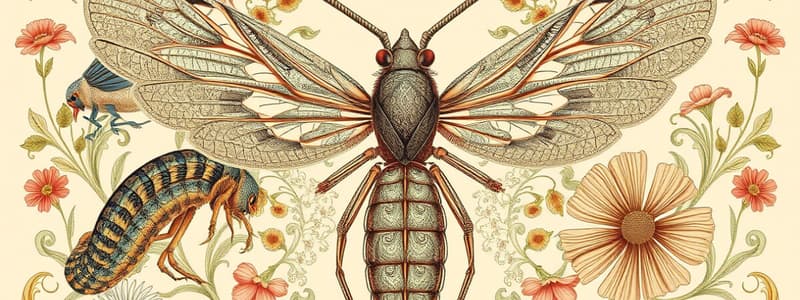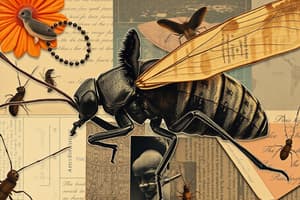Podcast
Questions and Answers
What is the definition of 'Porifera'?
What is the definition of 'Porifera'?
- Sponges (correct)
- Jellyfish
- Flatworms
- Roundworms
What is the definition of 'Cnidarian'?
What is the definition of 'Cnidarian'?
- Segmented worms
- Jellyfish (correct)
- Flatworms
- Clams
What is the definition of 'Platyhelminthes'?
What is the definition of 'Platyhelminthes'?
- Insects
- Starfish
- Roundworms
- Flatworms (correct)
What is the definition of 'Nematoda'?
What is the definition of 'Nematoda'?
What is the definition of 'Annelida'?
What is the definition of 'Annelida'?
What is the definition of 'Mollusca'?
What is the definition of 'Mollusca'?
What is the definition of 'Arthropods'?
What is the definition of 'Arthropods'?
What is the definition of 'Echinoderms'?
What is the definition of 'Echinoderms'?
Flashcards are hidden until you start studying
Study Notes
Major Groups of Invertebrates
-
Porifera:
- Commonly known as sponges.
- Simple organisms that lack true tissues and organs.
- Mostly marine and known for their porous bodies.
-
Cnidarians:
- Includes jellyfish, corals, and sea anemones.
- Characterized by radial symmetry and a simple body plan.
- Possess specialized cells called cnidocytes for capturing prey.
-
Platyhelminthes:
- Known as flatworms.
- Often parasitic (e.g., tapeworms) or free-living (e.g., planarians).
- Have a bilateral symmetry and a flat body structure.
-
Nematoda:
- Referred to as roundworms.
- Found in diverse environments, including marine, freshwater, and soil habitats.
- Notable for their cylindrical body shape and complete digestive system.
-
Annelida:
- Commonly called segmented worms.
- Examples include earthworms and leeches.
- Exhibit bilateral symmetry with a body divided into segments.
-
Mollusca:
- Includes clams, oysters, squids, and snails.
- Possess a soft body, generally protected by a hard shell.
- Exhibit diverse forms and habitats, ranging from aquatic to terrestrial.
-
Arthropods:
- Encompasses insects, crabs, lobsters, and ticks.
- Characterized by an exoskeleton, segmented body, and jointed appendages.
- The largest group of animals, highly diverse with various adaptations.
-
Echinoderms:
- Includes starfish, sea urchins, and sand dollars.
- Exhibit radial symmetry, primarily in adults.
- Possess a unique water vascular system for movement and feeding.
Studying That Suits You
Use AI to generate personalized quizzes and flashcards to suit your learning preferences.




